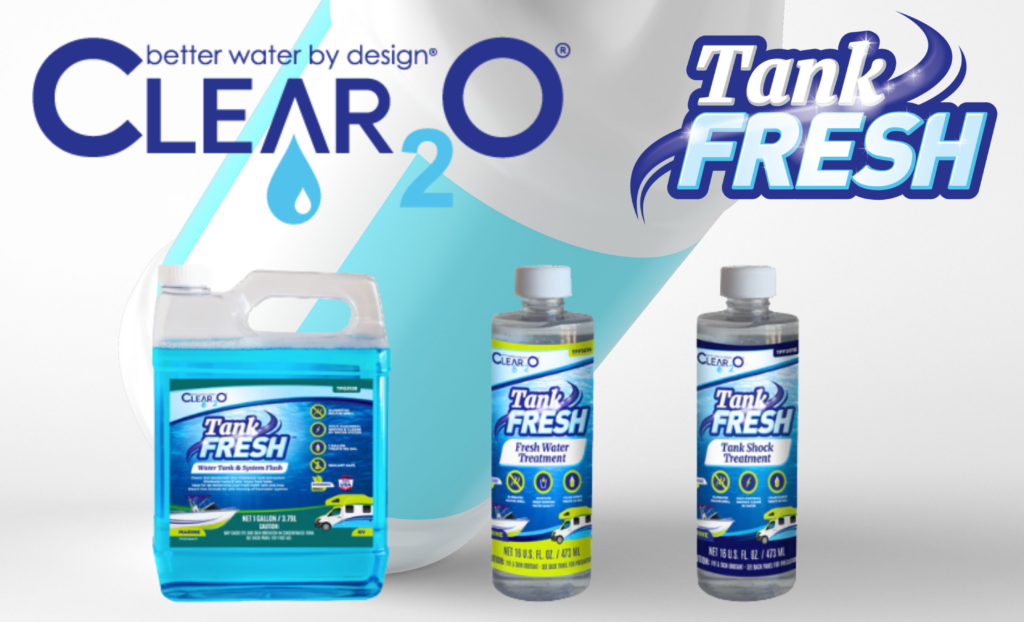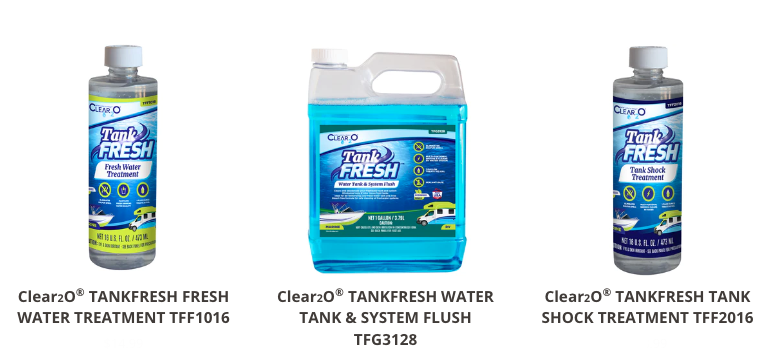
In partnership with Clear2O
Clear2O’s TankFRESH Is A Safe & Effective Alternative To Bleach
As RVers, we’ve all gone down the path of using bleach to sanitize our RV fresh water tank. Bleach is cheap, readily available, and known to kill germs. Bleach, however, has a host of other problems as outlined below.
From a practical standpoint…using bleach seems easy, in that you run each faucet after treating the water until a bleach smell comes out, let it all sit for a while, empty and refill the tank with fresh water, and rinse it all out again. Granted, that’s an abbreviated version, but you get the idea.
My problem with using bleach, assuming I have managed to stumble upon the correct ratio of water to bleach, is that all the plumbing smells like bleach for a long time afterwards. I find myself filling, emptying, and rinsing my RV fresh water tank more than necessary because I’m afraid we might ingest even a small amount of bleach. When your RV holds 90 gallons of water…that’s a lot of additional expense. I also have to hope I don’t splash any of it on my clothes or shoes. It all just feels wrong.
TankFRESH by Clear2O has a solution
Well-known water filtration experts, Clear2O®, have come up with a great solution called TankFRESH. TankFRESH consists of three products, but for our purposes here, we’ll be talking more about the Clear2O® TankFRESH Water Tank & System Flush. Though it costs quite a bit more than a gallon of bleach, hear me out. I think you’ll find the process and the peace of mind to be well worth it.
How to use TankFRESH Water Tank & System Flush
Using TankFRESH System Flush is very easy. One gallon will treat 100 gallons of water. My RV fresh water tank holds 90 gallons of water, but will actually take 95 gallons before it starts to come out of the overflow, so I used a full gallon jug of TankFRESH.
Start by filling your tank halfway with fresh water. For me, that was 45 gallons or so. I used one of these water flow measuring gadgets from Amazon to make it very simple. Once I had the tank half full, I poured in the entire gallon of TankFRESH and filled the RV fresh water tank the rest of the way. As soon as the overflow started dribbling, I shut off the water.
Clear2O® recommends moving your RV back and forth a few times to slosh the mixture around a bit in your water tank. Next, you’ll want to turn on the water pump and run every faucet and showerhead for about three minutes to ensure that the sanitizing mixture has permeated throughout. I even ran some through the toilets… but that’s just me. Let that sit about 30 minutes, then do it one more time.
Afterwards, drain the remaining fresh water from your water tank and fill it with fresh water when you are ready. You should run each faucet for a minute or two with the fresh water you have just added.
My observations
Obviously, the first thing you will notice during this process is the lack of bleach smell. In fact, TankFRESH has almost no discernible odor at all, though occasionally you catch a slight whiff of something pleasant you can’t really pin down. As bad as the bleach smell can be, it does give you a clear indication that you are running the sanitizing mixture through your lines.
Fortunately, with TankFRESH, I observed a change in the water flow that provided the same comfort without the bleach. Once the TankFRESH/water mixture began to flow into each sink or shower, I noticed a slight bubbling. Not like soap bubbles, more like if you had swapped out the stock faucet aerator for a super-fine aerator, creating those tiny, temporary air bubbles. That’s when that slight, there-but-not-really-there, pleasant fragrance came through, almost like glass cleaner. Likewise, when running the fresh water through during the final step, seeing those air bubbles go away ensured I had run the sanitized water all the way through and was now getting the fresh water from my tank.
The net result is that I had all of the confidence of proper sanitization, but none of the bleach hassle, smell, or worry. Clear2O® does recommend removing your water filters for this process. This is a great time to inspect and possibly replace them with new ones. Clear2O® has a 2-in-1 dual filtration water filter that combines both a pre-filter stage and a solid carbon stage, all in one filter.
Overall, it was a very satisfying experience and well worth the convenience and peace of mind. Though I have used the TankFRESH name here loosely, speaking mostly about the Water Tank & System Flush, the TankFRESH line actually includes their Water Treatment product and their Shock Treatment.

Water treatment for your RV fresh water tank
TankFRESH Water Treatment is ideal for treating your fresh water tank after you have filled it with water from a campground or water source that you aren’t quite as comfortable with, and just want that little extra measure of safety. I will also use it if I have filled my water tank in preparation for a trip, but don’t leave for a few days. The TankFRESH Water Treatment will keep your water fresh for up to 90 days.
TankFRESH Shock Treatment
The TankFRESH Shock Treatment is similar to their standard TankFRESH Water Treatment, in that it’s designed to be used when your RV fresh water tank still tastes “off”, even after sanitization. It’s also great for freshening up the tank when bringing an RV out of winter storage when it has been sitting for a long time.
Why bleach is bad for sanitizing your RV fresh water tank
Using bleach to sanitize an RV fresh water tank may not be necessarily “bad” if done correctly and occasionally as part of an overall maintenance strategy. However, certain issues may arise due to improper or excessive use. Therein lies the problem… improper and excessive use. With so many sources of information, how can you really know what the correct procedures and ratio of water to bleach are? Here are the top five reasons to avoid using bleach to sanitize your RV fresh water tank.
1. Residual smell and taste: Overuse or insufficient rinsing can leave a residual chlorine taste and smell in the water system, which may make the water unpleasant for consumption or other uses.
2. Corrosion: Prolonged or frequent exposure to bleach can corrode metal parts of the system over time. This is because bleach is a strong oxidizer and can cause rust on stainless steel and other metal parts.
3. Damage to seals and gaskets: The chlorine in bleach can degrade rubber or plastic components in your RV’s water system, such as seals and gaskets. This can potentially lead to leaks and system failures.
4. Health hazards: In high concentrations, bleach can be harmful if ingested. Although diluting it greatly reduces this risk, it’s still a concern to consider.
5. Environmental impact: Improper disposal of bleach-water can harm the environment. Bleach is toxic to many forms of wildlife, especially aquatic life.
Bleach is just not worth the hassle
The benefits of knowing instead of guessing, as well as the time savings, make TankFRESH Water Tank & System Flush worth the additional cost over bleach.
TankFRESH cleans and deodorizes your RV fresh water tanks, water supply lines, and fixtures. Its chlorine-free formula is safe for cleaning of freshwater systems, and it’s a biodegradable, professional strength formula. Best of all, there’s no mixing or guesswork required. Visit Clear2O.com and check out their line of TankFRESH products.

So, what are the chemicals in this Clear 20 tank Fresh product? It has to have something to kill bacteria, fungi, etc. that we are trying to get rid of in our water tanks and systems.
I’m with you what are the ingredients?
Well Maureen, if you really want to know–
One of the main ingredients is N-Alkyl dimethyl benzyl ammonium chloride (C12-C18)
This compound belongs to the class of organic compounds known as alkyldimethylbenzylammonium chlorides. These are organic compounds consisting of a quaternary ammonium group substituted with a benzyl group, two methyl groups as well as an alkyl chain.
It is not as bad as it sounds. This is also the main ingredient in cleaning wipes.
Other ingredients include 2-propanol, quaternary ammonium compounds, and water.
So….. what you’re saying is…..
Don’t use bleach pay lots more and use our product because it’s way better.
But this product is N-Alkyl dimethyl benzyl ammonium chloride.
What’s that last part there? OH CHLORINE
What’s that right before the chlorine? OH ALUMINUM… an element linked to dementia, alzheimers, and other medical issues.
BLEACH = sodium hypochlorite
CLEAR2O = N-Alkyl dimethyl benzyl ammonium chloride
I think I’ll stick with the bleach and save my money and my mental capacity.
Can this solution be used in the hot water tank so i don’t have to bypass it?
Can this be used to clean the hot water tank and not bypass it
Whatever you use, I would drain the tank afterwards; with a tank and the incoming water mixing with the contents, seems like it would take forever to get the sanitizing chemical out.
Interesting. Where can i purchase it and how much does it cost?
I’ve always used either sodium meta-bisulfate, or potassium meta-bisulfate (which I prefer because it doesn’t leave a salty residual flavor/aroma). As an old brewer and vintner, I’ve used these products to sanitize everything from equipment to must and hot liquor. Very versatile and inexpensive. Last time I bought a pound, it was under $5, and at 1 gram per gallon dilution rate, it lasts seemingly forever. I recommend mixing up the entire needed amount with a gallon of solution, then fill your tank to capacity. Then just do the regular recirculation through your water lines. Optionally, you can also drain the entire solution into your gray tank to sanitize that also. While the general amount of contact time is 3~15 minutes, I like to leave it overnight, as even plastic water tanks, which are quite porous, need longer to seep into all the nooks and crannies. Share, and enjoy!
This would be great except for the fact that shipping is half of the cost of the product ! Where else can it be purchased other than online?
Hello Edwin, I really liked your idea!
Question, If I have a 40 gallon fresh water tank, is one gallon of water mixed with one gram of potassium meta bisulfate enough to to sterilize the tank or do i need more?
If it’s used in brewing, perhaps there’s a brewer’s supply store nearby?
What happens if sone of the water is left In the tank after you try to empty it….. is this stuff bad for you if you end up drinking sone mixed with your water???
For $35/gal? I think that I’ll stick with bleach
Informative article. I am already a fan of clear2o products. Just got the Tankfresh about a month ago and so far so good. I hated putting bleach in my tank and having to wait hours. This is quicker and easy and no bleach smell. Happy camper.
How does sloshing a half full tank allow sufficient contact time to kill pathogens? Is this product carry NSF62 (drinking water safe rating)? I use a small amount of NSF62 rated sodium hypochlorite (bleach) annually to kill bacteria in my tank. I am a certified water treatment professional in the state of California.
what percent of sodium hypochlorite is in NSF 62? and where do you find this bleach? is it the same as household bleach?
to exspensive for what it dose, going to stay with bleach. We use bottled water for drinking, cooking any way as you should.